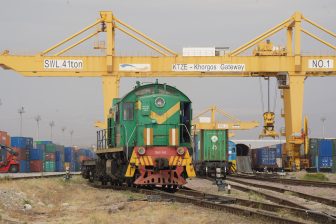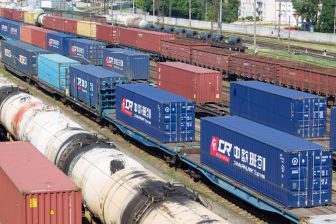
First shipment of ‘sanctioned goods’ through Russia planned
The first test shipment of previoulsy sanctioned goods through Russia has been planned. Before the end of March, UTLC ERA in partnership with RZD Logistics will operate the first train journey through Russian territory, carrying goods that were previously banned on land transportation routes. The green light for this type of transport has been anticipated since June last year and will open up a new market for Eurasian rail freight.
The test shipment will be carried out sometime next week, and if everything moves according to plan, regular rail freight services of previously sanctioned goods will start in April, says Larisa Kuznetsova of UTLC ERA. Goods that were previously sanctioned include agricultural products and foodstuffs.
“There is currently a great demand of certain food stuff in China, especially as freight flows have been disturbed due to the coronavirus outbreak. There are things that China really needs at the moment.” In general, China lacks meat products as beef and pork, as well as fish, wine and beers, dairy, or other food products. Flowers from the Netherlands are another popular import product, all of which were banned for transit through Russia.
Electronic seals
Effective per 1 July 2019, the Ministry of Transport of the Russian Federation announced a lifting of the ban of sanctioned goods, as long as the cargo is on transit to third countries. However, a long period of uncertainty followed. The transport was subjected to certain conditions, among which the presence of an electronic seal on the cargo. This would ensure that it could be tracked along the journey.
It is now clear that the seal will have to be applied at the Russian border, rather than the point of departure, explains the Russian logistics expert. This will be done at the border between Belarus and Russia, and Russia and Kazakhstan at the other end of the chain. Exactly how long this takes, will have to become clear in the test journey, Kuznetsova adds.
“Beginning this year the Russian government started tendering for the application of this seal. The contract has been won by a Russian company,” Kuznetsova explains. The tendering process followed a long period of documentation preparation by the Russian government. The technical details of the journey had to be reshaped, and this takes time, sources reported at the time of the announcement.
Groundbreaking
The decision to allow for the transit of previously sanctioned cargo is considered a major breakthrough for Eurasian rail freight traffic. The transit of these products was banned since August 2014 if originating from Europe, Norway, the US, Canada or Australia.
The ban has had great impact on rail freight traffic between Europe and Asia, as Russia is one of the main transit countries on the New Silk Road. Until now, agricultural products, raw materials and foodstuffs could only be transported to China via routes bypassing Russia, resulting in much longer transit times.
Uncertainty
Ever since the announcement, there has been a lot of uncertainty as to how the conditions should be met. Some companies explained that they are currently investigating the situation, before taking action. Others are not sure of this is actually taking place, because there is little confirmation from the official authorities.
With the first test shipment on the agenda, this uncertainty should gradually be taken away. “We depend on the customers for the actual operation of regular services, and we realise that this is not an easy time for especially European companies”, said Kuznetsova. However, she hopes that it is an impetus for Eurasian rail freight at a difficult time. In the end, these products are really needed, she concludes.
Webinar
Do you want to watch the webinar that RailFreight.com organised earlier about the lifting of than ban? Below you find the replay of this webinar.





